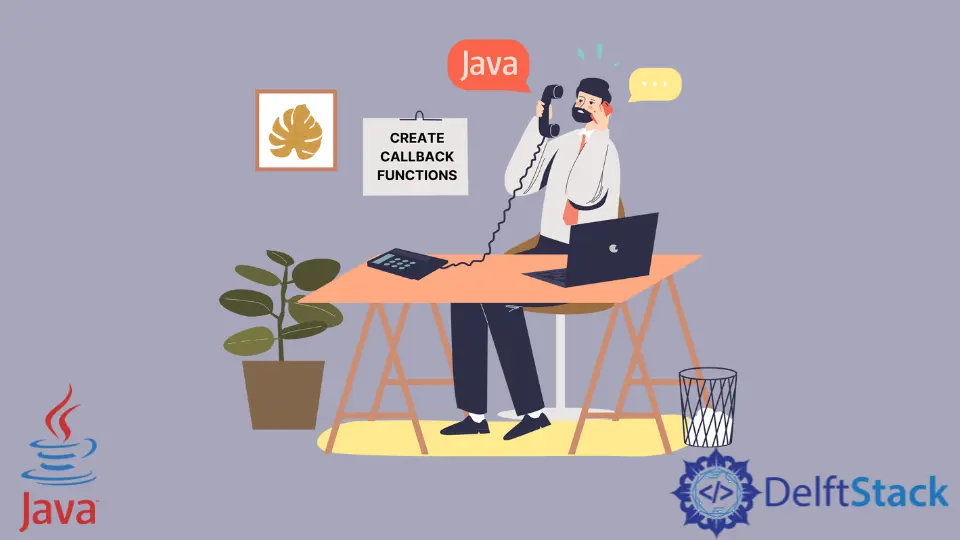在 Java 中创建回调函数
Sheeraz Gul
2023年10月12日

回调功能用于事件驱动编程。当相应事件发生时,引用将传递给调用的函数。
我们使用接口来实现 Java 中的回调,因为它不支持函数指针。
本教程演示如何在 Java 中创建和使用回调函数。
在 Java 中使用接口创建回调函数
Java 中的接口是指定类行为的抽象类型。它是一个类的蓝图类。
我们可以创建一个接口和多个类来演示 Java 中的回调。
下面的代码实现了一个接口和四个类来计算员工的工资。要调用函数,我们传递接口的引用;这是回调。
该代码通过从总工资中减去 10% 来计算净工资。查看每个类的输出;我们运行代码四次。
import java.util.Scanner;
// Create interface
interface Salary {
double Person_Salary();
}
// Class for Jack's Salary
class Jack implements Salary {
public double Person_Salary() {
return 5000.0;
}
}
// Class for Michelle's Salary
class Michelle implements Salary {
public double Person_Salary() {
return 4000.0;
}
}
// Class for Jhonny's Salary
class Jhonny implements Salary {
public double Person_Salary() {
return 3000.0;
}
}
// Class for Mike's Salary
class Mike implements Salary {
public double Person_Salary() {
return 3500.0;
}
}
class Employee_Salary {
public static void main(String[] args)
throws ClassNotFoundException, IllegalAccessException, InstantiationException {
Scanner sc = new Scanner(System.in);
System.out.println("Enter the Employee Name: ");
// name of the employee
String Employee = sc.next();
// Store the employee name in an object temp
Class temp = Class.forName(Employee);
// Create the new object of the class whose name is in temp
// Interface Salary's reference is now referencing the new object created above
Salary reference = (Salary) temp.newInstance();
// Call the method to calculate net salary and pass interface reference - this is a callback.
// Here reference refers to the function Person_Salary() of both Jack and Michelle's classes
Calculate_Salary(reference);
}
static void Calculate_Salary(Salary E_Salary) {
// calculate Salary Deduction Which is 10 percent
double salary_deduction = E_Salary.Person_Salary() * 0.1;
// The gross salary
double gross_salary = E_Salary.Person_Salary();
// Calculate the net salary
double net_salary = gross_salary - salary_deduction;
// Show the net salary
System.out.println("The Net Salary of Employee is =" + net_salary);
}
}
输出:
Enter the Employee Name:
Jack
The Net Salary of Employee is =4500.0
Enter the Employee Name:
Michelle
The Net Salary of Employee is =3600.0
Enter the Employee Name:
Jhonny
The Net Salary of Employee is =2700.0
Enter the Employee Name:
Mike
The Net Salary of Employee is =3150.0
在 Java 中创建同步和异步回调函数
同步回调
代码执行将等待或阻止同步回调的事件,直到它返回响应。回调将在返回调用语句之前执行其所有工作。
同步有时似乎滞后。下面的代码为回调函数实现了一个简单的同步任务。
// Create Interface
interface Delftstack {
void delftstack_event();
}
class Delftstack_Two {
// Delftstack Field
private Delftstack Delft;
// setting the register_delftstack function
public void register_delftstack(Delftstack Delft) {
this.Delft = Delft;
}
// This is our synchronous task
public void Hello_Delftstack() {
// perform any operation
System.out.println("Hello! This is delftstack callback from before the synchronous task.");
// check if listener is registered.
if (this.Delft != null) {
// invoke the callback method of class A
Delft.delftstack_event();
}
}
// Main
public static void main(String[] args) {
Delftstack_Two Demo_Object = new Delftstack_Two();
Delftstack Delft = new Delftstack_One();
Demo_Object.register_delftstack(Delft);
Demo_Object.Hello_Delftstack();
}
}
class Delftstack_One implements Delftstack {
@Override
public void delftstack_event() {
System.out.println("Hello! This is delftstack callback from after the synchronous task.");
}
}
输出:
Hello! This is delftstack callback from before the synchronous task.
Hello! This is delftstack callback from after the synchronous task.
异步回调
另一方面,异步回调不会阻止代码执行。
在 Java 中,我们需要创建一个线程来开发一个异步任务,并在里面实现回调。当调用从事件返回时,它返回到异步的回调函数。
下面的代码示例为回调函数实现了一个简单的异步任务。
// Create Interface
interface Delftstack {
void delftstack_event();
}
class Delftstack_Two {
// Delftstack Field
private Delftstack Delft;
// setting the register_delftstack function
public void register_delftstack(Delftstack Delft) {
this.Delft = Delft;
}
// The Asynchronous
public void Hello_Delftstack() {
// An Asynchronous must be executed in a new thread
new Thread(new Runnable() {
public void run() {
System.out.println("Hello! This is delftstack operation inside the asynchronous task.");
// check if Delft is registered.
if (Delft != null) {
// invoke the callback method of class A
Delft.delftstack_event();
}
}
}).start();
}
// Main
public static void main(String[] args) {
Delftstack_Two Demo_Object = new Delftstack_Two();
Delftstack Delft = new Delftstack_One();
Demo_Object.register_delftstack(Delft);
Demo_Object.Hello_Delftstack();
}
}
class Delftstack_One implements Delftstack {
@Override
public void delftstack_event() {
System.out.println("Hello! This is delftstack callback from after the asynchronous task.");
}
}
输出:
Hello! This is delftstack operation inside the asynchronous task.
Hello! This is delftstack callback from after the asynchronous task.
作者: Sheeraz Gul
Sheeraz is a Doctorate fellow in Computer Science at Northwestern Polytechnical University, Xian, China. He has 7 years of Software Development experience in AI, Web, Database, and Desktop technologies. He writes tutorials in Java, PHP, Python, GoLang, R, etc., to help beginners learn the field of Computer Science.
LinkedIn Facebook